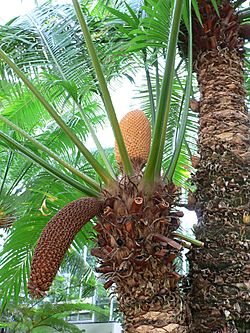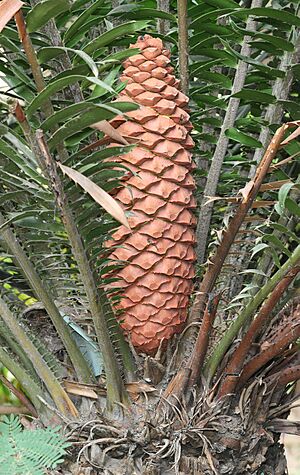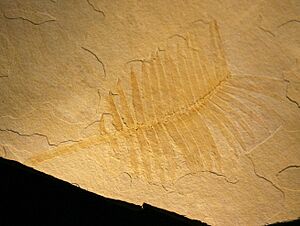Cycad facts for kids
Quick facts for kids Cycadophyta |
|
|---|---|
 |
|
| Cycas circinalis with old and new male cones. | |
| Scientific classification | |
| Kingdom: | |
| Division: |
Cycadophyta
|
| Class: |
Cycadopsida
|
| Order: |
Cycadales
|
| Families | |
|
Cycadaceae Cycas family |
|
Cycads are ancient seed plants. Their fossils show they first appeared a very long time ago, during the early Permian period.
These plants were super common during the Mesozoic era. This was the time when dinosaurs roamed the Earth! Today, cycads are still alive, but there are far fewer of them. We only know of about 9 different groups (called genera) and around 100 types (called species) that are still living. Scientists think cycads grew from plants called seed ferns, which are now completely extinct.
Cycads look different from most other plants. They have big, leafy tops with many leaves that look like feathers. They also have a thick, strong trunk. Cycads are evergreen, meaning their leaves stay green all year. They are also dioecious, which means each plant is either male or female.
People often confuse cycads with palm trees or ferns. But cycads are only distantly related to them. Instead, they belong to their own special group called the division Cycadophyta.
What Are Gymnosperms?
Cycads are a type of plant called gymnosperms. This means they have "naked seeds." Their seeds are not covered or hidden inside a fruit, like the seeds of flowering plants (angiosperms). Instead, cycad seeds are open to the air. This allows them to be directly fertilized by pollination.
Flowering plants, or angiosperms, have seeds that are enclosed. They also have more complex ways of getting fertilized. Cycads have very special helpers for pollination. These are usually certain kinds of beetles that help move pollen from one plant to another.
Cycads and Their Roots
Cycads have a cool trick! They can "fix nitrogen" with the help of tiny living things called cyanobacteria. These bacteria live in special roots of the cycad, which are called "coralloid" roots because they look a bit like coral. Nitrogen fixing helps the plant get important nutrients from the air.
These cyanobacteria can make a natural substance that is found in cycad seeds. If these seeds are eaten, this substance could potentially affect health. It's a good reminder that some plants have natural defenses!
Images for kids
See also
 In Spanish: Cícadas para niños
In Spanish: Cícadas para niños






